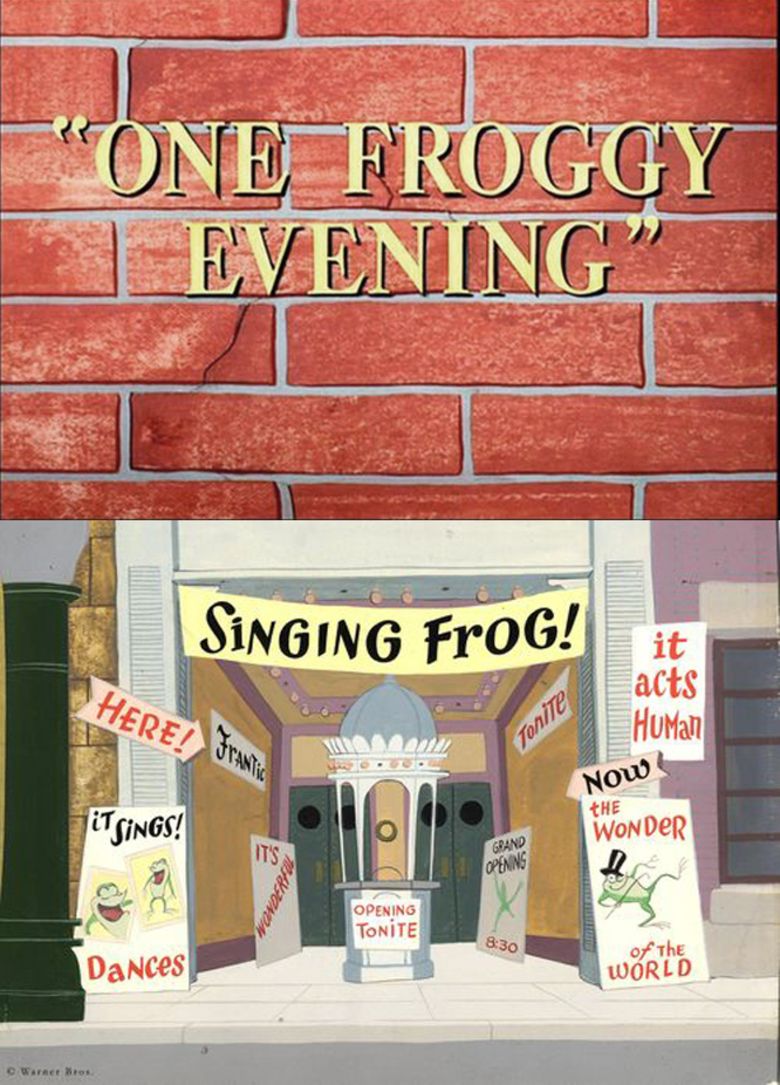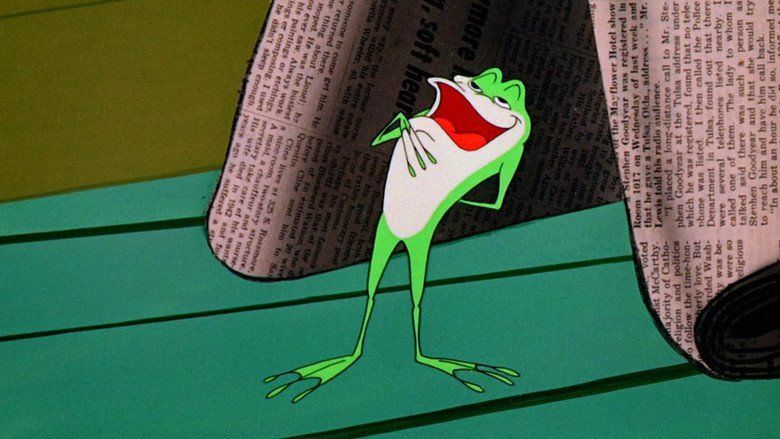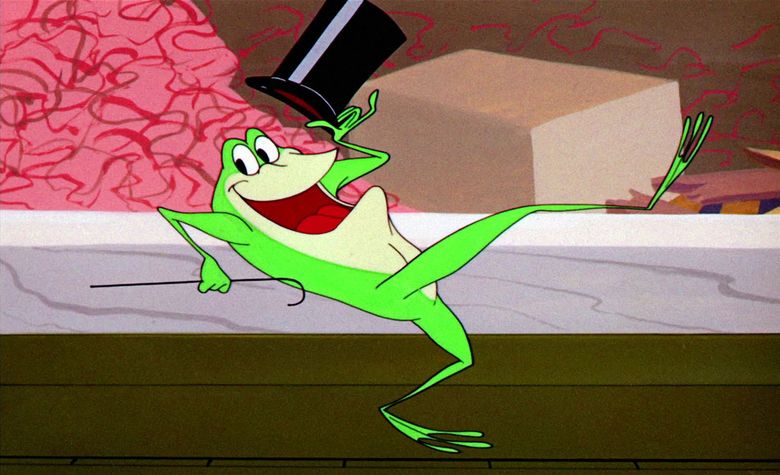One Froggy Evening
8.6 /10 1 Votes
Director Charles M. Jones Country United States | 8.6/10 IMDb Genre Animation, Short, Comedy Duration Language English | |||||||||||||||||||||||||||||||||
 | ||||||||||||||||||||||||||||||||||
Release date December 31, 1955 | ||||||||||||||||||||||||||||||||||
One froggy evening 1955
One Froggy Evening is an approximately seven-minute long Technicolor animated short film written by Michael Maltese and directed by Chuck Jones, with musical direction by Milt Franklyn. The short, partly inspired by a 1944 Cary Grant film entitled Once Upon a Time involving a dancing caterpillar in a small box, marks the debut of Michigan J. Frog. This popular short contained a wide variety of musical entertainment, with songs ranging from "Hello! Ma Baby" and "I'm Just Wild About Harry", two Tin Pan Alley classics, to "Largo al Factotum", Figaro's aria from the opera Il Barbiere di Siviglia. The short was released on December 31, 1955 as part of Warner Bros.' Merrie Melodies series of cartoons.
Contents

Steven Spielberg, in the PBS Chuck Jones biography Extremes & Inbetweens: A Life in Animation, called One Froggy Evening "the Citizen Kane of animated film" (Looney Tunes Golden Collection, Volume 5, Disc 2). In 1994 it was voted #5 of the 50 Greatest Cartoons of all time by members of the animation field. In 2003 the United States Library of Congress deemed the film "culturally significant" and selected it for preservation in the National Film Registry.

The film is included in the Looney Tunes Golden Collection: Volume 2 DVD box set (Disc 4), along with an audio commentary, optional music-only audio track (only the instrumental, not the vocal), and a making-of documentary, It Hopped One Night: A Look at "One Froggy Evening".
Plot
A mid-1950s construction worker involved in the demolition of the "J. C. Wilber Building" finds a box inside a cornerstone. He opens it to find a commemorative document dated April 16, 1892 Inside is also a singing, dancing frog, complete with top hat and cane. After the frog suddenly performs a musical number there on the spot, the man tries exploiting the frog's talents for wealth. The frog, however, refuses to perform for any individual other than its owner, instead devolving into deadpan croaking in the presence of others. First, the man takes the frog to a talent agent. When that fails, he takes out his life savings to rent an old theater (he is only able to get an audience with the promise of "Free Beer"). The frog performs atop a high wire behind the closed curtain, but finishes and reverts to a plain old frog once the curtain stars rising.
As a result of these failed attempts to profit from the frog, the man is now destitute and living on a park bench where the frog still performs only for him. A policeman overhears this and approaches the man for disturbing the peace, but when the man points out the frog as having done the singing, the officer takes the man into custody. He is committed to a psychiatric hospital along with the frog, who continues serenading the now hapless patient. Following his release, the now homeless, haggard and broken man, carrying the frog inside the box, spies the construction site where he originally found the box, and dumps it into the cornerstone of the future "Tregoweth Brown Building" before sneaking away. The timeline then jumps to 2056 (101 years after the cartoon's debut). The Brown Building is being demolished using futuristic ray guns, and the box with the frog is discovered yet again by a 21st-century demolition man, who, after envisioning riches as well, absconds with the frog to start the process once again.
Sequel
In 1995, Chuck Jones reprised Michigan J. Frog in a cartoon entitled Another Froggy Evening, with Jeff McCarthy providing the Frog's voice. It actually serves as both a prequel and a sequel to some degree. Most of Another Froggy Evening follows, in order, a caveman from pre-historic times, a citizen of the Roman Empire, and a Patriot in 1776 at the time of the American Revolution. All three basically encounter the same scenario as the man in One Froggy Evening: they each find the frog (apparently always in the same box), it performs a musical number for each of them on the spot, the three men try to exploit the frog's talents, and the frog refuses to perform for anyone else. For the caveman, he eventually gets pelted by stones before sliding the frog's box under a rock. The Roman is eventually sent to be fed to the lions, but escapes from the Colosseum and tosses the frog's box into a river. The Patriot, after attempting to show off the frog to George Washington, gets locked up in a pillory.
The cartoon then flashes-forward to "Later (Actually, Quite a Bit Later)" and a man marooned on a deserted, tropical island. He pulls the frog's box out of the water while fishing, but his immediate thought after hearing it sing is to eat the frog instead. But before he can toss it into a cauldron, the frog's box is pulled out of the sky by a flying saucer hovering over the island. Inside the spaceship, Marvin the Martian expresses his delight that he has captured a specimen of an "operatic earthling". After opening the box and hearing the frog initially croak, Marvin finds that it speaks Martian. Marvin answers the frog's question (which apparently was what the frog was repeatedly trying to ask all along throughout this cartoon and One Froggy Evening) by replying, "Yes, I would love to hear you sing". Marvin then joins the frog singing "Let the Rest of the World Go By" as the ship leaves Earth's orbit.
Inspirations
The premise of One Froggy Evening closely follows that of the 1944 Columbia Pictures film Once Upon a Time starring Cary Grant in which a dancing caterpillar is kept in a shoebox. It was common for Warner Bros. to parody scenes from well-known live action films for its Merrie Melodies productions. Once Upon a Time, in turn, was based on "My Client Curley", a 1940 radio play adapted by Norman Corwin from a magazine story by Lucille Fletcher. Ol' Rip, a horned toad "discovered" in an 1897 time capsule inside the cornerstone of the Eastland County, Texas courthouse in 1928, is also said to have inspired the premise.
Some of the Frog's physical movements are evocative of ragtime-era greats such as Bert Williams, who was known for sporting a top hat and cane, and performing the type of flamboyant, high-kick cakewalk dance steps demonstrated by the Frog in Hello! Ma Baby.
The cartoon also had a sequel of in an episode of the Warner Bros. series Tiny Toon Adventures, with the Frog falling into Hamton J. Pig's possession. Another cameo of Michigan J. Frog was in an episode of Animaniacs when a scene from Macbeth is recreated. Michigan J. Frog, wearing his top hat, is placed into a boiling cauldron along with other cartoon characters.
Songs featured
Several of the songs performed by the frog were written after he was presumably sealed into the cornerstone, dated 1892.
The two men who find the Frog are the only persons who see him singing. However, the theatre audience probably heard him behind the closed curtain and the police officer definitely heard him singing in the park. (The Frog stops singing before he can be seen either by the theatre audience or by the police officer.)
Other media
References
One Froggy Evening WikipediaOne Froggy Evening IMDb One Froggy Evening themoviedb.org
